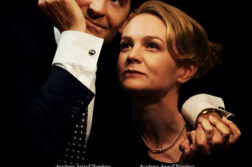IF YOU WERE to ask a teenage boy what he thought of a movie that was nearly devoid of women characters and was instead filled with muscular, handsome men who are often physical with each other and sometimes scantily dressed, you would probably get an answer that included the word “gay,” in both teenage senses of the word (homosexual and bad). And yet, that same young man might well be part of the huge audience of young men who flock to the action movies that feature just this sort of scenario.
Modern action films have their roots in that most macho of genres, the Western. Classic Westerns featured morally righteous heroes defeating evil men and action sequences like shootouts, showdowns, stunts on horses, and old-fashioned fist fights. The next evolutionary step in the action genre was the rise of the maverick cop film, with movies like Bullitt (1968) and The French Connection (1971) emerging in the late ’60s and early ’70s. The maverick cop genre was essentially an update of the Western in which the action was moved from the Old West to contemporary urban areas, and horse stunts were replaced with car chases, but the gritty violence and the theme of good and evil remained intact. A third major step happened in the early 1970s with the rise of martial art films like Enter the Dragon (1973) and The Big Boss (1971). These films focused more on hand-to-hand combat than on gun battles or chase scenes.
Then came the ’80s, and a new style of action movie started to make its way to American theaters. These films were hybrids, taking elements from the earlier genres. They featured the same tropes of gun fights and stunts. The heroes were men who worked within an authoritative institution such as the police or the military, but they were outsiders who opposed the establishment and focused on their own sense of morality. Another feature of these movies was more hand-to-hand combat, as in the many martial arts films of this era. But what was really new and different about these movies was that they starred men with chiseled bodies who usually shed more and more clothing as the film went on. And they starred actors, such as Sylvester Stallone and Arnold Schwarzenegger, who were not chosen for their acting skills but for their macho physique.
Throughout this history, the heroes have always been men who were ostensibly straight, indeed masculine to a fault. And yet, for just as long, these action films have flirted with gay subtexts. Even the most macho films have often included allusions to gay culture, and some of them have even featured gay characters. As action movies continued to progress from the 1980s, the subtext has evolved as well, so that homosexuality has moved from subtle hints to obvious metaphors and even outright eroticism. What follows are several examples that I hope will demonstrate this historical sequence.
Ben-Hur (1959)
 The 1950s was definitely not the best time for screenwriters to openly include gay characters or storylines in a film, but that doesn’t mean they weren’t secretly used. A perfect example of this hidden subtext is William Wyler’s Ben-Hur, which stars Charlton Heston in the title role.
The 1950s was definitely not the best time for screenwriters to openly include gay characters or storylines in a film, but that doesn’t mean they weren’t secretly used. A perfect example of this hidden subtext is William Wyler’s Ben-Hur, which stars Charlton Heston in the title role.







